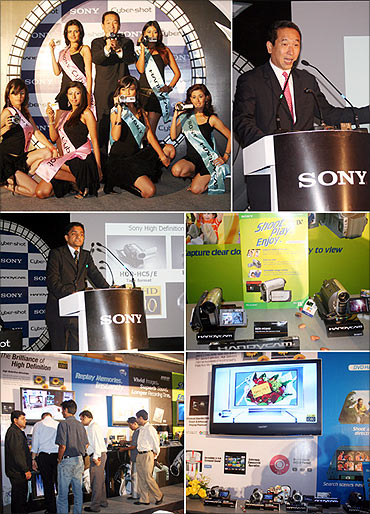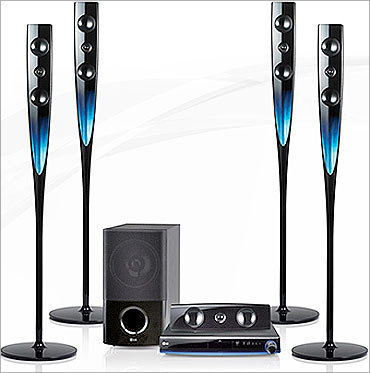Photographs: Courtesy, Samsung. Bhupesh Bhandari in New Delhi
Some time in the middle of 1994, the Dhoots of Videocon put their brightest man, Ravinder Zutshi, on a special project. They had been approached by Samsung which was keen to sell its consumer electronics in India.
The Korean company had proposed a joint venture which could source products from Videocon's factories at Aurangabad in Maharashtra. Zutshi was asked to study the possibilities.
Quantitative research threw up no surprises. Unaided awareness about Samsung was close to zero, aided awareness was slightly better at 7 per cent. People thought the Japanese were the masters of all technology, and the Koreans were at best imitators.
But when he dug deeper, Zutshi found deep dissatisfaction amongst consumers from multinational (Sony, Sanyo, National, Philips and others) as well as Indian (Videocon, Onida, BPL et al) brands.
The consumers' aspiration and awareness were high, but the technology made available to them was low. And there was no indication that any of them would invest in the latest technology. After-sale service existed only on paper.
The success of LG, Samsung in India
Image: Ravinder Zutshi, Deputy Managing Director, Samsung IndiaRavinder Zutshi's report said there was a big gap that could be exploited. With better technology, contemporary products and a customer-friendly disposition, Samsung stood a fair chance in the market. The Dhoots trusted Zutshi.
If Samsung did well, they argued, their factories at Aurangabad would run at full capacity, and whenever the foreign investment rules were further liberalised, they could sell their stake to the Korean chaebol and make a neat pile of money. Quickly, they formed a 49:51 company with Samsung. It was 1995.
Around the same time, LG (it was at that time known as Lucky Goldstar) sent a large and high-powered team to India. The odds were stacked against the company -- low awareness of its brand, poor perception of Korean technology and so on.
But the team saw that the Japanese were not too interested in India; Europe and the US were their primary focus. This had made Indian brands complacent, and they lacked the financial wherewithal to come out with cutting-edge technology.
The success of LG, Samsung in India
Image: K R Kim, Vice Chairman and CEO, Videocon Industries.Photographs: Courtesy, Videocon.
LG also found out that education was very high on the agenda of Indians. The team members knew that it was education that had transformed South Korea from a poor agrarian country into a developed industrial powerhouse in a matter of decades.
The same would happen in India, the team reported to its bosses back home. The LG brass was convinced and made up its mind to enter India. As rules did not allow a fully-owned subsidiary, it first tried its luck with Bestavision and then with Chandra Kant Birla. Finally, in 1997, when the foreign ownership rules were relaxed, it came on its own.
Cut to the present. In most product categories of the consumer electronics market, LG and Samsung lord it over a market share of over 40 per cent -- television, refrigerators, air-conditioners, washing machines and microwave ovens. Outside South Korea, this has not happened in any other large market.
In certain categories, their products sell at prices similar to Japanese rivals -- a clear indication that the perception of the Koreans being poor cousins of the Japanese is history.
Their brand recall is universal. Indian brands, with the exception of Videocon, which has now hired ex-LG honcho Kwang Ro Kim as chief executive, are on oxygen. LG did business of $2.8 billion in 2009. India accounts for about 6 per cent of LG's worldwide turnover.
The success of LG, Samsung in India
Image: Moon Bum Shin, Managing Director, LG India.Photographs: Courtesy, LG.
"We want to raise it to at least 10 per cent by 2012," says LG India Managing Director Moon Bum Shin.
"By 2015, India will become the second largest contributor to LG's revenue after the US and ahead of (South) Korea," he adds. Samsung crossed the $2-billion mark in 2009 -- India is around 2 per cent of its global turnover. How did the Koreans get the better of rivals in India?
Strong foundation
Both LG and Samsung knew that half measures wouldn't work in India. Thus, LG has invested $300 million and Samsung $200 million in two production facilities each.
"It wasn't a global factory that also supplied to India. We didn't want to make the customers wait," says Rajeev Karwal, who drove sales and marketing at LG from 1997 to 2003, then headed Philips and Electrolux in India, and now runs a consultancy for small-scale enterprises called Milagrow.
The success of LG, Samsung in India
Image: LG SteamWasher.Photographs: Courtesy, LG.
Apart from Videocon, no rival of the Koreans has put up large production facilities. "In terms of investments and technology, no other Indian company apart from Videocon had the might to rival them," says Videocon Chairman Venugopal Dhoot.
LG and Samsung brought the latest products, customised them to Indian conditions (Samsung, for instance, reduced the size of the freezer in its fridges because Indians didn't want it; LG cut out all frills that were not required in India) and began to give quick after-sale service.
Samsung, says Zutshi, now deputy managing director, Samsung India (the Dhoots exited the venture in tranches by 2002; it had broken even by 1998), was the first in the industry to give uniform training to all technicians.
"When pagers came in July 1995, we gave one to all technicians across metros," says he. Also crucial were the Korean price tags. LG as well as Samsung prices were up to 20 per cent below Sony, but around 10 per cent higher than Indian rivals. The brands were positioned as value for money.
They spent large sums of money on brand promotion. Both LG and Samsung now earmark 4 to 5 per cent of their turnover for brand development, above- as well as below-the-line.
This translates to ad spends of at least Rs 400-500 crore (Rs billion) from each. In the initial days, when they were yet to build scale, help poured in from their Korean parents in liberal measures. The Koreans knew little about cricket but were quick to join the bandwagon in India.
The success of LG, Samsung in India
Image: Samsung refrigerators.Photographs: Courtesy, Samsung.
But how did they address the quality perception? For the first three months, Samsung campaigns focused on its technological achievements. It was, after all, the world leader in colour picture tubes and semiconductors.
"If you don't want the best, go to Sony, National and Philips, we said in our advertisements," says Zutshi. Karwal says he was able to convince the LG brass that it should build on its Korean heritage and not hide it. "The company wanted to play on the Goldstar brand because it had some recall. But I argued that it had failed in India so why harp on it? We went ahead with LG. I said let's not pretend to be what we are not."
"Where they have scored," says the top functionary of a rival, "is that they treated India differently than other Asian markets." And they ambushed rivals whenever they could. Karwal says when he came to know that Sony was ready to launch its flat-screen television, he rushed to Seoul and managed a consignment of 500 flat-screen televisions to launch first.
"I also got to know that Sony had booked the centrespread of a publication. So, I bought the wrap-around which said ours was the flattest thing on earth."
The success of LG, Samsung in India
Image: Competition from Japanese giants.Photographs: Courtesy, Sony.
The Japan factor
This, says Karwal, and others agree, was possible because Koreans are more aggressive than the Japanese, and are quick to take decisions. "It is a hierarchical society. So, decisions taken at the top are implemented quickly," says he. "They don't bother so much about the outcome," adds Zutshi.
"They believe in doing things; whether they win or lose they see later." According to Shin: "The inherited characteristics are different. When there was war in Africa, most companies fled. But the Koreans stayed on." But there aren't too many Koreans in these companies -- LG has no more than 13 Koreans in its staff of over 4,000, Samsung has less than 30 in around 4,000.
Still, LG and Samsung owe a debt to their neighbours across the sea -- they were quick to adopt the best manufacturing practices of Japanese companies. Samsung, for instance, uses the just-in-time supply principal with its vendors -- they need supply only when the factory demands.
Its vendor development exercises could be straight out of the Japanese management textbook. "They (the Koreans) combine American marketing with Japanese manufacturing," says Karwal.
The success of LG, Samsung in India
Image: Sony camera.Photographs: Courtesy, Sony.
"Panasonic has been in the Indian market for long but, as a part of strategy, the focus has been increased exponentially since last year or so." The Japanese also went after the premium slots in the market, and thereby missed the volumes. "LCD television is the only segment where we compete (with the Koreans) but here too our and their key target segments are different. We are focused on households with an annual income above Rs 5 lakh, unlike the Koreans," says Sony India Managing Director Masaru Tamagawa.
The question is, have the Koreans taken an unassailable lead over the Japanese? The Japanese take heart from their large market share in automobiles, cameras, cordless phones, small appliances and LCD televisions. Panasonic, for one, is aiming for growth of over 100 per cent in each of the next two years, and double-digit market share in LCD television.
"Coming from the Japanese domain, the quality and reliability of products is our strength. The challenge is to make this strength reach the consumer," says Ito. "The retail experience is also the key. Therefore, we have continuously expanded our brand shops and presence at other retail counters." But this is the game the Koreans seem to have perfected.
The success of LG, Samsung in India
Image: A tough fight in India.Photographs: Courtesy, Samsung.
Trade relations
When the Koreans first came to India, the consumer electronics trade was archaic and in disarray. All producers had appointed distributors who then sold to the dealers. There was thus little direct contact between the dealer and the company.
No company had a full portfolio of products, so the dealer had to deal with several producers and their distributors. Companies that did have more than one product had separate divisions for each line, which often didn't talk to each other.
This only compounded the dealer's headache. Companies encouraged multiple dealers in every location -- the rivalry kept the trade margins low.
"The first thing we did," says Zutshi, "was that we cut out the distributor." This, at one stroke, improved the profit margins of the dealers. More important, it improved their bankability.
And dealers, who were reluctant to invest at the behest of the distributors, began to jazz up their showrooms. Of course, they began to push the Samsung brand with gusto, though its price tags were higher than those of Indian brands.
The success of LG, Samsung in India
Image: LG Home Theatre system.Photographs: Courtesy, LG.
LG too took a new approach. Instead of going to all, it identified the best dealer in every locality, the one with maximum footfalls. It made sure that the dealer did not face competition from others in the vicinity.
As a result, the dealer, who earlier got no more than 5 to 6 per cent commission on sale, now began to get as much as 12 per cent. This was unprecedented in the history of Indian consumer electronics.
The goodwill helped LG and Samsung expand quickly to the heartland. And that was the key to its success. Ever since, dealership for a Korean brand has been more profitable than others.
This is a point even rivals do not dispute. Onida Vice-president (sales, service and marketing) Sriram K says that the Koreans invested upfront and got the rewards later. "At one point, LG was even known as a credit brand because of how flexible it had become in trade circles," says he.
"It realised that doing business in India needed flexibility and therefore extended credit to dealers unlike a lot of other multinationals. Now that it has strong relations with the trade, it has tightened the terms. But the initial flexibility helped it garner volumes." That's the learning.
Additional contribution from Amit Ranjan Rai & Sayantani Kar












article